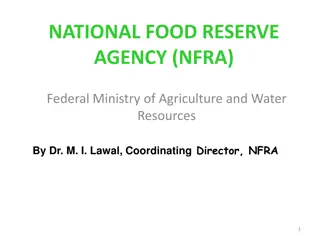Understanding the Ecological Impact of Food Production and Consumption in Greece
Our food comes from various sources, and it's essential to consider its ecological footprint on the environment. Through research conducted by the 27th Primary School of Trikala, Thessaly, Greece, valuable insights were gained about the origin and buying preferences of Greek families regarding food. The impact of different food categories on the environment was analyzed, highlighting the importance of local production, healthy nutrition, and sustainable practices in agriculture. By making informed choices in food consumption, we can contribute to reducing the energy footprint on Earth and protecting natural resources.
Download Presentation

Please find below an Image/Link to download the presentation.
The content on the website is provided AS IS for your information and personal use only. It may not be sold, licensed, or shared on other websites without obtaining consent from the author. Download presentation by click this link. If you encounter any issues during the download, it is possible that the publisher has removed the file from their server.
E N D
Presentation Transcript
Where does our food come from? 27thPrimary school of Trikala, Thessaly Greece Aristeides Pappas 5thand 6thgrades. School year 2021-2022
Our nutrition and the environment Our nutrition is very important, not only for our health, but also for the protection of the environment, since the right nutrition can contribute to the reduction of the energy footprint on Earth. CO2 By reducing the carbon dioxide CO2 emission. GARBAGE H2O By sustaining our natural resources, like water! By reducing the volume of our garbage. ENERGY By saving energy AGRICULTURE By using ecologic methods in Agriculture Healthy nutrition WE CAN HELP! Local production By eating healthily, we become and remain healthy. By consuming food that is produced in our country.
What is the ecological footprint of food? By this term, we mean the total impact that is caused on the environment by a certain kind of food or a food group, during all the procedures of its production, processing and consumption. STEP 1 STEP 4 Production STEP 2 STEP 6 Transport Consumption Processing STEP 3 STEP 5 Distribution Standardization
A RESEARCH QUESTIONNAIRE ABOUT THE ORIGIN OF THE FOOD. The students of our school that are participating in this project, have answered to the questions, with the help of their parents. The aim of this questionnaire highlight the buying behavior of the families in Greece, as far as food is concerned. This research helped us to serious results about the eating buying preferences of the Greek families. was to come and to some conclusions, habits and Approximately 74 families of our school students have participated in this research, in total.
RESEARCH QUESTIONNAIRE ABOUT THE ORIGIN OF THE FOOD WE EAT The participants were asked to answer to questions about the origin of the food they prefer to buy, for example, local, from all over Greece, from Europe or the rest of the world. S/N FOOD CATEGORIES QUANTITY 1 Food and pastries 7 2 Fruit 8 3 Vegetables 11 More answers about 62 kinds of food, that belong categories. specifically, they gave 4 Dairy products 6 to 8 general 5 Sweets 9 The students worked out the questions after they had first studied the impact of each food category environment presented their results. 6 Meat and fish 8 7 Legumes 5 on then the they and 8 Various food 8
FOOD GROUPS VARIOUS FOOD BREAD AND PASTRIES Eggs, nuts, dry fruit, olive oil, seed oil, butter, juice, fizzy drinks. bread, biscuits, cookies, pies, rusks, bread sticks. FRUIT SWEETS Cakes, chocolate, croissants, creams, candies, lollipops, traditional syrup sweets. Oranges, lemons, tangerines, apples, pears, kiwis, bananas,grapes. VEGETABLES Lettuce, tomatoes, cucumber, onion, broccoli, cauliflower, beetroot ,carrot, zucchini, peppers, eggplants. MEAT AND FISH Beef, pork, lamb, goat, chicken, rabbit, fish, seafood. DAIRY PRODUCTS Milk, yoghurt, feta cheese, yellow cheese, kasseri cheese, graviera cheese. LEGUMES Dry beans, lentils, chickpeas, split peas.
HOW OFTEN DO YOU BUY FOOD THAT IS PRODUCED IN YOUR AREA? The majority of the participating students (over 80 per cent), have answered always or almost always, prefer buying food that is produced in their area. They believe that the food that is produced away from the place consumed, leaves energy footprint environment. But it is also a general belief, products are healthier. that they 45 40 where a on it is 35 higher the 30 25 41.9 40.5 20 that safer local and 15 10 14.9 5 1.4 1.4 0 ALMOST NEVER RARELY SOMETIMES OFTEN ALWAYS
BREAD AND PASTRIES The majority of Greek families prefer buying bread and various pastries that are produced in our area, Trikala, or in other places around Greece. Bread and pastries from various countries around Europe are preferred in a very low percentage. ( 6,8%). LOCAL FROM OTHER PLACES IN GREECE EU INTERNATIONAL 93.2 100.0 89.2 85.1 90.0 79.7 75.7 80.0 70.0 62.2 58.1 60.0 50.0 35.1 40.0 32.1 24.3 30.0 20.3 14.9 20.0 8.1 6.8 6.8 2.7 10.0 1.4 1.4 0.0
THE ENERGY FOOTPRINT OF BREAD AND PASTRIES In this bar diagram, we can see that bread, that is very popular in Greece, has the lowest energy footprint of any other product in this particular category. On the other hand, rusks have the highest energy footprint. Rusks 22.7 Traditional rusks 21.5 Cookies 19.9 Bread sticks 19.4 Pies 14.6 Cookies 13.9 Bread 12.4
From our research, we found out that the majority of the Greek families prefer buying fruit from local producers. It is a strong belief that they are healthier and some of them are organic products (without chemical fertilizers).The only exception are the so- called exotic fruit like bananas, which are imported from abroad. FRUIT LOCAL GREECE EU INTERNATIONAL 87.8 86.5 90.0 75.7 80.0 74.3 70.0 60.8 60.8 60.0 51.4 45.9 50.0 39.2 39.2 39.2 40.0 33.8 30.0 23 16.2 20.0 12.2 10.8 9.5 9.5 8.1 5.4 4.1 10.0 1.4 1.4 1.4 1.4 1.4 0.0
From this bar diagram, it comes out that fruit coming from other countries, bananas, have the highest energy footprint. But grapes that are grown country in a range, have energy footprint. them are very popular in Greece! THE ENERGY FOOTPRINT OF FRUIT 1-100 like in our Bananas 36.6 very the wide lowest Both Lemons 25.9 of Kiwis 24.8 Oranges 23.6 Tangerines 23.3 Pears 19.8 Apples 19.8 Grapes 19.4 0 5 10 15 20 25 30 35 40
VEGETABLES As far as vegetables are concerned, most of the families prefer local products. Most of the local products are organic vegetables, so they are safer and healthier. LOCAL FROM GREECE EU INTERNATIONAL 89.1 90.0 83.8 79.7 79.7 78.4 78.3 77 75.7 80.0 68.9 70.0 63.5 60.8 60.0 50.0 37.8 36.5 40.0 31.1 24.3 30.0 23 21.6 20.3 20.3 20.3 16.2 20.0 9.5 1.4 10.0 1.4 1.4 0.0
THE ENERGY FOOTPRINT OF VEGETABLES 1-100 From our research it comes out that almost all vegetables have a very low energy footprint, because they are mostly local products. Lettuce 5 Peppers 5.7 Zucchini 5.9 Cauliflower 5.9 Eggplants 6 Broccoli 6.1 Cucumber 6.1 Tomato 6.1 Beetroot 6.5 Onion 6.7 Carrot 6.9 0 1 2 3 4 5 6 7 8
From our research, it comes out that the majority of the Greek families prefer dairy products that are produced in our country. At this point, we must mention that in our area, Trikala, there are a few very good factories that produce excellent dairy products! So our students have answered that they prefer mostly local dairy products, like milk, feta cheese, kasseri cheese etc. DAIRY PRODUCTS LOCAL FROM GREECE EU INTERNATIONAL 87.8 90.0 79.7 80.0 70.3 66.2 66.2 70.0 59.4 60.0 50.0 40.0 33.8 33.8 29.7 30.0 23 20.3 20.0 12.2 10.8 6.8 10.0 0.0 Milk Yoghurt Feta cheese Yellow cheese Kasseri cheese Graviera cheese
From this bar diagram we can see that the highest energy footprint comes from the yellow cheese we use to make our sandwiches. This cheese is mostly, imported from northern European countries. On the other hand, local dairy products, especially milk and feta cheese, have low energy footprint. ENERGY FOOTPRINT OF DAIRY PRODUCTS 1-100 Milk 11.3 Feta cheese 12.2 Yoghurt 12.6 Kasseri cheese 16.3 Graviera cheese 17.7 Yellow cheese 20 0 5 10 15 20 25
Our students have answered that their families prefer buying sweets from local shops and local factories. They also buy chocolates that are made in Greece mostly. And very few of them sometimes buy , sweets and chocolates, which are imported from other European countries. SWEETS AND CHOCOLATES LOCAL FROM GREECE EU INTERNATIONAL 90.0 82.3 81 79.7 78.3 78.3 80.0 71.5 68.9 68.9 70.0 55.4 60.0 50.0 39.2 40.0 29.7 25.7 23 30.0 18.9 16.1 14.9 20.0 10.8 9.5 5.4 5.4 5.4 4.2 4.1 4.1 4.1 4.1 4.1 10.0 1.4 1.4 1.4 1.4 1.4 0.0
In this bar diagram, it is obvious that traditional sweets and local products have the lowest energy footprint. ENERGY FOOTPRINT OF SWEETS AND CHOCOLATES 1-100 One of the most popular sweets though, chocolate, seems to have the highest impact on the environment. The explanation is simple: Tons of chocolates are imported in Greece every year from other European countries, because of their excellent quality!! Birthday cakes 13.2 Traditional syrup sweets 14.4 Cakes 14.9 Puddings 18.1 Croissant 20 Small chocolate bars 23.1 Candies 23.2 Lollipops 23.4 Chocolate 23.4 0 5 10 15 20 25
Greek families prefer fish and sea food from the Greek seas in a very high percentage. It s normal since our country is surrounded by sea and fishing is a very common habit in Greece, especially in the Greek islands. Very small quantities of fish and sea food are imported in Greece, mostly frozen products. They also prefer local meat in a very high percentage, too. MEAT AND FISH LOCAL FROM GREECE EU INTERNATIONAL 86.5 90.0 81 79.7 78.4 75.6 80.0 72.9 70.0 59.5 56.8 60.0 50.0 41.8 39.1 40.0 30.0 23.0 23.0 20.2 18.9 20.0 10.8 9.5 5.44.1 10.0 4.1 2.7 1.4 1.4 1.4 1.4 1.4 0.0 Beef Pork Lamb Goat Chicken Rabbit Fish Sea food
ENERGY FOOTPRINT OF MEAT AND FISH 1-100 According to the results of our research, it comes out a universal truth!! Eating sea food and fish has the largest and also the worst impact on our planet! Greece could not be the exception to this rule Lamb 9.9 Goat 10 Pork 10.2 Beef 10.6 On the other hand, lamb, goat and pork, which are bred in our country by local producers in a traditional way, have the less impact on our planet. Chicken 11.5 Rabbit 11.7 Fish 15.8 Sea food 16.6 0 2 4 6 8 10 12 14 16 18
Our research has shown that the majority of Greek families prefer legumes that are produced in various areas of Greece. It seems that they buy and consume legumes that are produced by local producers at a rate almost 100 per cent. LEGUMES LOCAL FROM GREECE EU INTERNATIONAL 89.2 90.0 85.1 77 80.0 74.3 70.3 70.0 60.0 50.0 40.0 29.7 30.0 24.3 23 20.0 13.5 10.8 10.0 1.4 1.4 0.0 Dry beans Giant beans Lentils Chickpeas Split peas
This bar diagram shows us that Giant beans and Split beans have the highest energy footprint on our planet. Whereas, dry beans have the smallest impact on Earth. THE ENERGY FOOTPRINT OF LEGUMES 1-100 Dry beans 19 Lentils 19.8 Chick peas 20.1 Giant beans 21 Split peas 21.1 17.5 18 18.5 19 19.5 20 20.5 21 21.5
Greek families prefer buying various food mostly from local producers in a large percentage. For example, the eggs are bought exclusively from local producers. Products from countries around Europe or from other countries outside Europe, are preferred in a very low percentage. VARIOUS FOOD LOCAL FROM GREECE EU INTERNATIONAL 89.2 87.8 86.5 90.0 81.1 75.7 74.3 80.0 70.0 59.5 55.4 60.0 50.0 37.8 36.5 40.0 25.7 30.0 20.0 10.8 10.8 9.5 9.5 8.1 8.1 6.8 5.4 5.4 10.0 2.7 2.7 2.7 2.7 2.7 2.7 0.0
As far as the energy footprint of various food is concerned, we can see that nuts, seed oil, margarine and dry fruit have the largest impact on our planet. In some cases, these products are imported from countries around the world. THE ENERGY FOOTPRINT OF VARIOUS FOOD 1-100 Eggs 12.7 Juice 18.8 Fizzy drinks 19.9 Eggs, a very popular food, has the lowest impact of all. Olive oil 19.9 Margarine butter 23.6 Dry fruit 23.9 Seed oil 24.1 Nuts 24.2 0 5 10 15 20 25 30
THE ENERGY FOOTPRINT OF ALL FOOD GROUPS 1-100 At this last bar diagram we can see the energy footprint of every food group. Meat and dairy products have the largest impact on our planet. 24 21 20 19 18 15 12 6 Whereas, fruit, vegetables and legumes have the lowest impact of all food groups.
THE ENERGY FOOTPRINT OF ALL FOOD GROUPS 1-100 In conclusion, the more the food is produced and consumed at a local level, the less is its impact on the environment and on Earth , in general. 24 21 20 19 18 15 12 6
Animal products have a larger energy footprint on our planet than plant type products From the results of our research, the conclusion is the following The 73% of the participants are aware of the fact that the animal products have a larger energy footprint than the plant type products. 16% Does not answer Wrong the 11% of the participants have a wrong belief that the animal products do not have a larger energy footprint on Earth than the plant type products. 11% Right 73% The 16% of the participants does not give an answer.
The greenhouse vegetables have a larger ecological footprint than the outdoor ones. From the results of our research, the conclusion is the following The 59% of the participants are aware of the fact that the greenhouse vegetables have a higher energy footprint on our planet than the outdoor ones. 18% Does not answer The 23% of the participants have a wrong belief that the greenhouse vegetables do not have a higher energy footprint than the outdoor ones. Wrong 23% 59% Right The 18% of the participants does not give an answer
Poultry meat has lower energy footprint than red meat. From the results of our research the conclusion is the following The 65% of the participants are aware of the fact that poultry meat has lower energy footprint than the red meat. 27% The 8% of the participants have a wrong belief that the poultry meat does not have a lower energy footprint than the red meat. Does not answer Wrong 8% 65% The 27% of the participants does not give an answer. Right
Local products have a lower energy footprint than the imported products. From the results of our research the conclusion is the following The 64% of the participants are aware of the fact that local products have a lower energy footprint than the imported from other countries products. 16% Does not answer The 20% of the participants have a wrong belief that local products do not have a lower energy footprint than the imported products. Wrong 20% Right 64% The 16% of the participants does not give an answer.
Dear friends and colleagues, as a general conclusion, let s all keep in mind that our eating habits have a strong impact on Earth!! Let s help our children acquire right eating habits. And don t forget! there is no planet B!! Thank you so much for your attention!!























